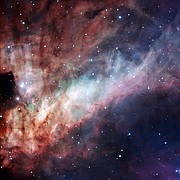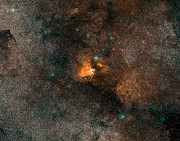Comunicato Stampa
Nuovo ritratto dei brillanti acquerelli della Nebulosa Omega
07 Luglio 2009
La Nebulosa Omega, una zona di formazione stellare dove le stelle nascenti illuminano e scolpiscono una vasta fantasia pastello di polveri e gas, è mostrata in tutta la sua gloria in una nuova immagine dell’ESO.
La Nebulosa Omega, a volte chiamata la Nebulosa del Cigno, è una splendida nursery stellare, distante circa 5500 anni-luce, in direzione della costellazione del Sagittario (l’Arcere). La nebulosa, una regione di gas e polveri, nella quale si formano nuove stelle, misura circa 15 anni-luce in larghezza e ha recentemente generato un gruppo di stelle massicce e calde. La luce intensa e i venti forti di queste enormi stelle nascenti hanno scolpito straordinarie strutture a filigrana nel gas e nelle polveri.
Se viene osservata con un telescopio piccolo, la nebulosa ha una forma che ricorda ad alcuni osservatori l’ultima lettera dell’alfabeto greco, omega; altri, invece, vedono un cigno con il suo collo lungo e ricurvo. Tuttavia, ci sono altri soprannomi per questa evocativa pietra miliare del cosmo fra cui Nebulosa Ferro di Cavallo e Nebulosa Aragosta.
L’astronomo svizzero Jean-Philippe Loys de Chéseaux scoprì la nebulosa intorno al 1745. Il cacciatore di comete francese Charles Messier la riscoprì indipendentemente circa vent’anni dopo e la comprese nel suo famoso catalogo col numero 17. In un telescopio piccolo, la Nebulosa Omega sembra un’enigmatica striscia spettrale di luce posta sullo sfondo delle distese di stelle della Via Lattea. I primi osservatori non erano sicuri se questo oggetto curioso fosse realmente una nuvola di gas o se fosse invece un lontano ammasso di stelle troppo indefinito per essere distinto. Nel 1866, William Huggins risolse la questione quando confermò che la Nebulosa Omega era una nuvola di gas brillante, utilizzando un nuovo strumento, lo spettrografo astronomico.
Negli ultimi anni, gli astronomi hanno scoperto che la Nebulosa Omega è una delle regioni di formazione stellare più giovane e più massiccia nella Via Lattea. Un’attiva nascita di stelle cominciò alcuni milioni di anni fa e continua fino ad oggi. Il gas che brilla intensamente, mostrato in questa immagine, è soltanto una bolla che erompe dal lato di una nuvola oscura di gas molecolare molto più grande. La polvere, che è così preminente in questa foto, proviene dai resti di calde stelle massicce che hanno concluso la loro breve vita e hanno risprigionato materia nello spazio. Il detrito cosmico dal quale si formano futuri soli ha la stessa origine.
L’immagine appena rilasciata, ottenuta con lo strumento EMMI, che è incorporato nel New Technology Telescope (NTT) dell’ ESO, che misura 3.58-metri e si trova a La Silla, in Cile, mostra la regione centrale della Nebulosa Omega in dettagli mirabili. Nel 2000, un altro strumento sull’ NTT, chiamato SOFI, ha catturato un’altra immagine straordinaria della nebulosa (ESO Foto 24a/00) nel vicino-infrarosso, che ha dato agli astronomi un’immagine che penetra attraverso la polvere oscura, e ha mostrato con chiarezza molte stelle precedentemente nascoste. Anche l’Hubble Space Telescope della NASA/ESA ha ritratto piccole parti di questa nebulosa (heic0305a e heic0206d) con precisi dettagli.
Alla sinistra dell’immagine, una nuvola di polvere enorme, con una strana forma di scatola, ricopre il gas brillante. L’affascinate tavolozza di ombre di colore tenue che si vede attraverso l’immagine, e’ dovuta alla presenza di gas differenti (per lo più idrogeno, ma anche ossigeno, nitrogeno e zolfo), che brillano sotto l’intensa luce ultravioletta irradiata dalle giovani e calde stelle.
Ulteriori Informazioni
L’ESO (European Southern Observatory) è la principale organizzazione intergovernativa di Astronomia in Europa e l’osservatorio astronomico più produttivo al mondo. È sostenuto da 14 paesi: Austria, Belgio, Repubblica Ceca, Danimarca, Finlandia, Francia, Germania, Italia, Olanda, Portogallo, Spagna, Svezia, Svizzera e Gran Bretagna. L’ESO mette in atto un ambizioso programma che si concentra sulla progettazione, costruzione e gestione di potenti strutture astronomiche da terra che consentano agli astronomi di fare importanti scoperte scientifiche. L’ESO ha anche un ruolo preminente nel promuovere e organizzare cooperazione nella ricerca astronomica. L’ ESO gestisce tre siti unici di livello mondiale in Cile: La Silla, Paranal e Chajnantor. A Paranal, l’ESO gestisce il Very Large Telescope, l’osservatorio astronomico nella banda visibile più d’avanguardia al mondo. L’ESO è il partner europeo di un telescopio astronomico rivoluzionario, ALMA, il più grande progetto astronomico esistente. L’ESO sta pianificando al momento un Telescopio Europeo Estremamente Grande ottico/vicino-infrarosso di 42 metri, l’E-ELT, che diventerà “il più grande occhio del mondo rivolto al cielo”.
Contatti
Henri Boffin
ESO
Garching, Germany
Tel.: +49 89 3200 6222
E-mail: hboffin@eso.org
Joerg Gasser (press contact Svizzera)
ESO Science Outreach Network
Email: eson-switzerland@eso.org
Sul Comunicato Stampa
| Comunicato Stampa N": | eso0925it-ch |
| Legacy ID: | PR 25/09 |
| Nome: | Omega Nebula, Swan Nebula |
| Tipo: | Milky Way : Nebula : Type : Star Formation Milky Way : Nebula : Appearance : Emission |
| Facility: | New Technology Telescope |
| Instruments: | EMMI |




